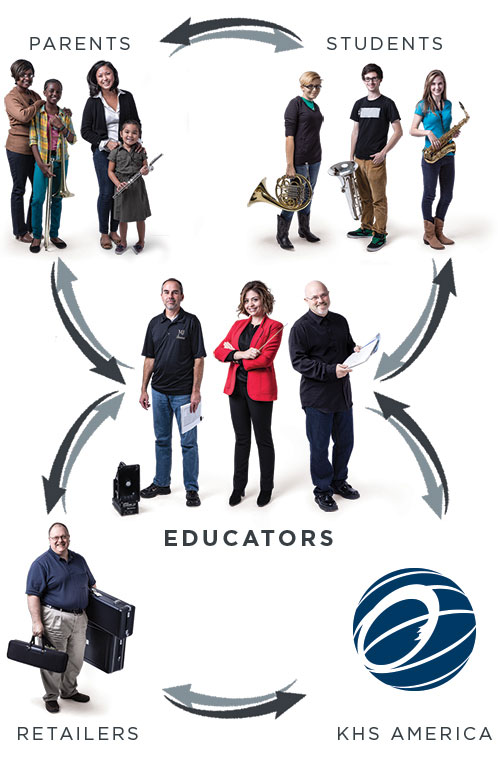INTRODUCTION
Steve Martin once said, “I’d do anything to get into shape – except to exercise and eat right.” He hit the nail on the head. The gap between what we “should do” and what we “do do” (insert joke here) is where we need to focus our efforts. For musicians, it’s often, “I’d do anything to get better at my instrument – except practice, analyze my weak points and be willing to sound like doodoo for a while while I improve.”
The gap between “should” and “do” often comes down to motivation. Our motivation to improve at any new skill ebbs and flows. It depends on a bazillion factors and can shift from moment to moment.
One way to work around the entire issue of motivation is through the creation of habits. Once a behavior becomes a habit, motivation becomes less important. The action, repeated over and over again, creates progress, and that progress leads to even more progress. Lather, rinse, repeat.
For our students, teaching them to create habits of their own is one of the most self-empowering superpowers we can bestow upon them.
Let’s talk about how.
HABIT CREATION BASICS
In the book “Atomic Habits,” James Clear outlines a simple four-step system for creating habits.
- Make it obvious. The habit-to-be must be so easy to trip over, it becomes automatic. Tie the habit to something the student does every day on auto-pilot. For example, if the student simply takes their instrument out of the case and assembles it as soon as they put their book bag down at home, they are already on their way.
- Make it attractive. This is where tracking will come in. In order for the point system to work, students will need to keep track of what they are doing and how many points they are accumulating, or how many days of a streak they have listed in their calendar. Hopefully, the tangible evidence of their progress will not only be seen in the calendar but also heard in the band room.
- Make it easy. As you’ll see below, I’ve listed some very simple tasks that can be tied to something the students do every day. For Clear, these fall into the category of “Two-Minute Rule” tasks. Anything on that list can be done in two minutes or less. We clearly want our students to spend more than two minutes on improvement but the goal here is to merely get the ball rolling. Oftentimes, playing a single note leads to a warm up or spinning through a favorite tune.
- Make it satisfying. This is where you can be a tremendous ally. In addition to simply establishing this practice and laying the ground rules, your check-ins on progress and celebration of milestones big and small, you can create a positive environment where students can regularly see that their efforts, no matter how small, all work to improve themselves and the band.
GETTING TO THE POINT(S)
Here we go! Below are a whole bunch of tasks that will help your students improve. I’ve broken them into categories related to effort, time spent, and pushing themselves. To some degree, the actual points and categories are arbitrary. Your mileage may vary. Use what works for you and feel free to ignore the rest.
ONE POINT EACH
- Take your instrument home
- Get your instrument out of the case
- Assemble your instrument
- Put music on stand/ipad
- Play one note
- Get your instrument in tune
FIVE POINTS EACH
- Warm up
- Play through your band music
- Sing through your band music
- Make an intonation chart for your instrument
- Play a favorite song or piece that you already know
- Play somewhere other than in your usual spot at home
- Listen to a recording of an expert on your instrument
- Share the recording with someone you know and tell them why you like it
- Read a Wikipedia article about the history of your instrument
- Play “the time game” – keep time to a metronome or recording while randomly muting it, notice your tendencies
- Explain to a non-musician what is special to you about making music
- Play in front of a mirror
- Make a list of your favorite pieces
- Make a list of your “someday” pieces
TEN POINTS EACH
- Improvise for one minute
- Record yourself on a tricky section
- Listen back to the recording and ask “How could I make this better?”
- Share the recording with someone and ask for feedback
- Play for someone close to you
- Teach someone something about your instrument
- Give your instrument a bath
- Clean out your music folder
- Clean out your case/gig bag
- Clean out your band locker
TWENTY POINTS EACH
- Transcribe a piece you like and play it
- Compose a melody and play it
- Make up a soundtrack for a funny video (or sad, peaceful, scary, whatever)
- Keep a practice log or journal
- Do a skills inventory (range, dynamics, speed, etc.)
- Make a “bad” sound, analyze what makes it bad and what you do (or don’t do) to make it that way
- Ask a professional a specific question about how to play your instrument
FIFTY POINTS EACH
- Play duets with a friend
- Go to hear an expert on your instrument play live
- Make a performance recording (audio or video)
- Share a performance recording
- Play for someone you don’t know
- Help a younger player
POTENTIAL SCORING STRATEGIES
- Most overall points
- Most points per category
- Most points per week/month/semester
- Most points for each section/grade
- Longest streak/most consistent
- Most improvement over time
- Shoot the Moon (do every item on every list at least once)
NOTE
Rewards can be whatever is a good fit for your band. It could be currency for merch or a discount on a band trip. Maybe it’s food-related. Maybe the winner(s) get to conduct a piece at the last concert or play a featured solo. You know what works best for your folks. Also, it may make sense to have smaller rewards on a more regular basis and save bigger rewards for the end of the year. You may also consider just using the one point challenges for a while to get your students into the swing of things. The important thing is to help encourage positive habit formation.
IN CLOSING
As music educators, we know that making music makes life better. We also know that it takes a lot of work over a long period of time to get there. Delayed gratification is not so fun, so the sooner we can help our students put their progress on auto-pilot through developing the habit of practice, the sooner we can see what they do (do) with those habits.
Sorry for the bad jokes.
Can’t stop myself.
It’s a habit.
BOOKS FOR MORE INFORMATION ON HABIT FORMATION
Atomic Habits, James Clear
The Power of Habit, Charles Duhigg
About the Author
LANCE LADUKE is internationally known as an educator, performer and creator. He teaches at Carnegie Mellon University as Artist Lecturer in Euphonium, Freshman Advisor and Coordinator of Special and Creative Projects. Lance teaches business, marketing and communications as part of the CMU Music Entrepreneurship Program, coaches and mentors a variety of chamber ensembles and is also Adjunct Professor of Euphonium at Duquesne University. Lance was a member of Boston Brass and the US Air Force Band in Washington DC, has performed with the Philadelphia Orchestra and currently plays with the River City Brass. He has taught and/or given master classes at some of the world’s finest conservatories, including Juilliard, the Royal Academy of Music in London and the Hong Kong Academy for Performing Arts. Lance co-wrote and produced “Band Blast Off,” a highly successful band recruiting DVD and maintains an active speaking career, sharing his thoughts on practice, leadership, and self-development. His wildly successful book, “Music Practice Coach, Five Workouts to Get the Most Out of Your Practice Time!” is available as a free PDF at lanceladuke.com. Lance is an Educational Ambassador for Jupiter Band Instruments.
The content of this Blog article or Banded Story is the intellectual property of the author(s) and cannot be duplicated without the permission of KHS America and/or the author(s). Standard copyright rules apply.



 We look forward to the evolution of this exciting program, and welcome feedback on how we can further enhance the work that you do in music education.
We are excited to offer your program the opportunity to join the KHS America Academic Alliance today.
We look forward to the evolution of this exciting program, and welcome feedback on how we can further enhance the work that you do in music education.
We are excited to offer your program the opportunity to join the KHS America Academic Alliance today.